
Morocco plans to adjust its upcoming budget to prioritise health, education, and reducing regional inequalities, Finance Minister Nadia Fettah Alaoui said. Youth-led protests have recently spread across the kingdom, exposing anger over poverty and public services amid ambitious infrastructure projects.
Alaoui told Reuters that protesters demanded better education and healthcare, highlighting frustration with stadiums and other high-profile projects ahead of 2030. The government currently spends just under 9% of GDP on health and education, she said, signalling room for more efficient allocation.
Authorities intend to communicate these efforts more effectively, demonstrating concrete improvements in hospitals and schools across local communities. “We will reallocate for short-term, quick wins, because people cannot wait for the reform to happen,” Alaoui explained in Washington.
Exact budget details remain under wraps until presentation to parliament, expected after late October, when discussions and debates will officially begin. The plan also aligns with King Mohammed VI’s push to reduce regional inequalities in mountainous and oasis areas, she added.
Additional funds will target efficiency and coordination without jeopardising Morocco’s broader macroeconomic stability, Alaoui emphasised, promising careful management of resources.
Regarding monetary policy, she said the government plans medium-term inflation targeting, projecting a 2%-3% goal by late 2026 or early 2027. The dirham remains pegged to a 60% euro and 40% U.S. dollar basket, allowed to float within a narrow 2.5% band.
Floating the currency fully remains distant, she said, citing small and medium-sized enterprises’ unpreparedness for such a move. On international debt, Alaoui said Morocco has no immediate plans to return to markets but expects to remain a regular issuer.
